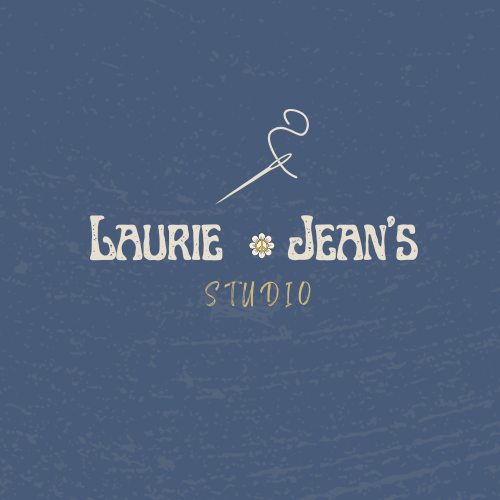The Hands That Taught Me - Larry’s Story
Content Warning: This post discusses family and memory in the context of loss
As I sit in my studio (which is a little spot in my basement that I claimed back after my son no longer needed his playroom), I think about what my Dad, Larry (Mac) McBee, would think of my recent endeavor.
He was a maker, a creative. He died in 2021 from a 10-year battle with Alzheimer’s. I feel his loss everyday and think about his influence in my life often. He was a deeply loving father who believed in his family and provided his children with every opportunity he could.
When I had the calling to create Laurie Jean’s Studio, I knew I would want to tell the story of my Dad as a creative and a maker. So, here is the first stab at that!
My Dad’s creative medium was primarily steel and metal. He learned to customize and restore antique and classic cars from his brother, Leo, in the late 50s, early 60s in southern California. SoCal was a Mecca for all things cars in the 50s and 60s. The first National Hot Rod Association race was held in 1953 at the Los Angeles County Fairgrounds (Landis, 2024). The rise of the “car culture” was evident during the 50s - drive-in theaters, diners, and cruising were popular pastimes for families and teens (McCandless Collection, The Role of Classic Cars in Defining Fashion and Lifestyle Trends, n.d.).
The “Kustom Kulture” that exploded in the 50s and 60s focused on art, vehicles, hairstyles, and fashion (my bailiwick) and was born out of SoCal and its hot rod culture (Von Dutch et al., 1993). This was the culture my Dad was immersed in during his time in SoCal. He learned how to modify and customize cars, as well as how to paint. His car painting skills were beyond reproach, and I am still amazed at how talented he was at painting a car.
My Dad considered himself an artist. He could manipulate metal and steel into any shape or concept that you could imagine. He did this with his hands and with tools. He was attuned to his work. I would watch him for hours as he worked on these cars in our family business. He would weld, patch, and sand metal, and then he would rub his hands over his work. Repeating that process unit he determined it was done.
I remember asking him once why he did that. He didn’t tell me, he showed me, telling me to rub my hands over a spot he had not perfected yet and then over a spot he had perfected. He asked me, “Can you feel the difference? Do you feel the low spots, the high spots, the rough spots?” He explained that it took “feeling the metal” to understand what he needed to do to get the metal into a stage that was appropriate for the next step of the process. See, without a perfect base, all the other work you do to that car doesn't matter; it will never be good enough because the base wasn’t good enough.
When I say he would rub and rub and rub, I mean it, often getting shards of metal stuck in his fingers and hands that my mother and I would have to dig out for him. His hands would be dusty from working the metal, and he would rub and rub. Then he would fix a spot. Rub and rub some more, and then fix a spot. It was mesmerizing.
I loved to watch my Dad work. Whether it was on cars, when he was an Insurance Executive, and we would attend his meetings and watch him interact with his sales teams, when he took up painting later in life, or all the times he renovated the houses we lived in (which was constant)! I would sit next to him, helping if I could, handing him tools, and mostly asking a lot of questions. Most days, he was patient with me and would answer all my questions. But some days, when the task was particularly challenging or he was not in the mood for a little girl’s questions, he was less talkative. But I still watched. I still observed and absorbed.
I do believe that his influence generated an interest in my desire to create. I loved playing with paper dolls, sticker books, drawing with fashion plates, and playing dress up with my Barbie dolls. I ultimately became obsessed with fashion design and sewing, receiving a degree in fashion design and working as a children’s wear designer and apparel product manager for an outdoor brand before completing my PhD in textile and apparel management.
Over the years, I have sewn, crafted, knitted, made candles, cross-stitched, you name it. Fabric was my preferred medium, and I could do nearly anything with fabric and a sewing machine. I may take a break from creating and making, like I did when my son was born. But, I eventually get the itch again to create and make.
I have never felt as talented as my Dad, but he was always so proud of the work I was doing and encouraged me every step of the way. I hope that someday I will feel as though I have matched his level of talent. Thanks, Pop, for sharing your love of creating and making with me and for answering ALL those little girl questions so many years ago. I love you and miss you!
References
Landis, M. (2024, April 8). How Southern California’s Car Culture Got Its Start. The Sun. https://www.sbsun.com/2024/04/08/how-southern-californias-car-culture-got-its-start/
McCandless Collection (n.d.). The Role of Classic Cars in Defining Fashion and Lifestyle Trends. https://www.mccandlesscollection.com/role-classic-cars-defining-fashion-and-lifestyle/#:~:text=The%201950s:%20The%20Birth%20of%20Automotive%20Glamour&text=These%20vehicles%20were%20not%20just,they%20spent%20their%20leisure%20time.
Von Dutch; Ron Turner; Ed Roth; Robert Williams (1 November 1993). Custom Culture: Von Dutch, Ed "Big Daddy" Roth, Robert (Bob) Bond, Robert Williams and Others. Last Gasp. pp. 7–. ISBN 978-0-86719-405-0. Retrieved 15 December 2012.
